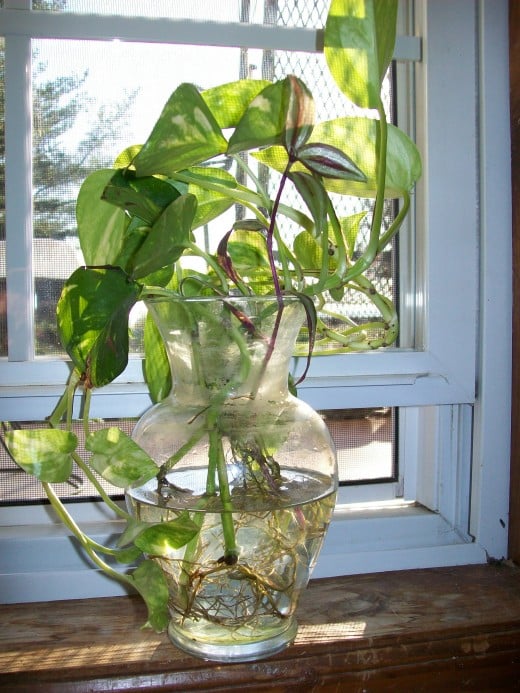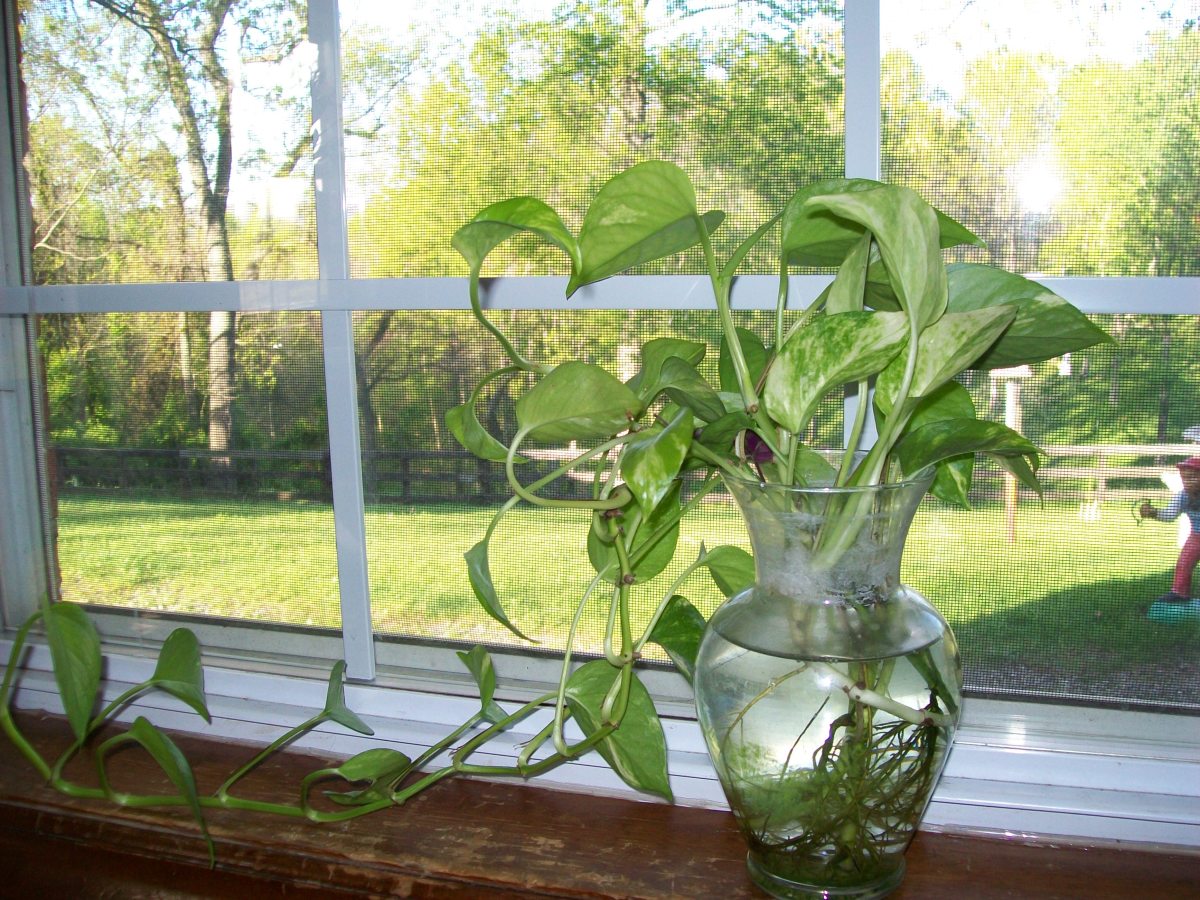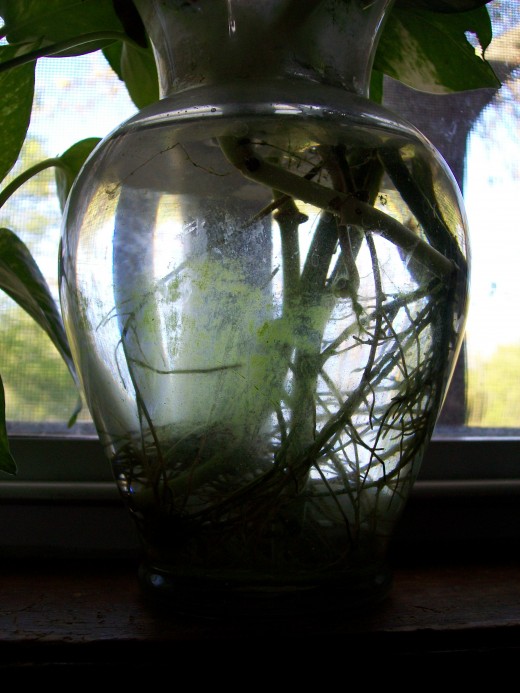Growing Devil's Ivy In Water

Houseplants Are Beneficial
Houseplants like Pothos (also known as Devil’s Ivy) can improve indoor air quality by removing CO2 and other contaminants from the air around them. In addition to removing contaminants from the air, they provide supplemental oxygen, which as we all know is necessary for the majority of life on Earth. However, potting soil can be messy and remembering to water the plants can sometimes be neglected with disastrous results.
Growing Devil's Ivy In Water

Can Pothos Grow In Water?
Instead of using soil, we can grow Pothos in nothing but water with a small amount of liquid fertilizer. No, this doesn’t involve expensive pumps, containers and special fertilizer. I’m talking about growing a plant in nothing but a cheap vase or jar, some tap water and Miracle-Gro! The best part of growing plants in water is that you can see at a glance if they need watering. That doesn’t sound too expensive or involved now does it?
Pothos, like many plants, will root readily from cuttings placed in water and will be content to grow like that as long as they’re provided with some nutrients and enough sunlight. Any container will do, so long as it holds water. Pothos is very hardy and can withstand quite a bit of neglect. In some countries and states, it is considered to be an invasive species as it can compete with native plants. However, there is no danger of Pothos taking over your home!
How To Grow Pothos In Water
First, you’ll need some sort of vase, jar, bottle or similar glass container. These can be found at very low cost at thrift stores such as Goodwill. Clear ones are nice, yet can make a perfect breeding ground for algae (the green slimy goop that typically grows in ponds). If you don’t want to clean your containers frequently, choose a darker color vase/glass/jar that will block out some light and slow the growth of algae.
Next, we’ll need some water. Tap water is usually fine. Plants can survive fairly well on this most of the time. However, if your tap water is chlorinated, you’ll have to let the water sit in an open container for about a day before pouring it in a jar with a new plant or watering an existing plant. This allows time for the chlorine, which can be harmful to plants, to dissipate from the water into the atmosphere.
Now, we’ll need to add just a little bit of fertilizer to the water before adding our Pothos. Any kind of liquid fertilizer will suffice for growing our Pothos. Miracle-Gro is the most commonly available liquid fertilizer in most stores. They produce a liquid fertilizer for African Violets, another common houseplant, and this mixture of nutrients is sufficient for most house plants as well. Simply add a few drops into your water, depending on how large your container is and how much water you have.
Finally, it’s time to add our plant. I suggest that if you know someone who has a Pothos plant, you ask them for a few cuttings. If not, then purchase a plant from your favorite nursery or garden center. When making cuttings select a section of stem, typically on the end of a vine, and cut off enough of the stem so that the individual section has at the very least to 3 nodes (points where roots and leaves grow from). A few more is ok, but the cutting can only support so many leaves until it forms new roots.
Remove a leaf or two from the end of the cutting, but not on the end where all new growth is occurring. Place your cuttings in your container, making sure that the cut ends are covered with water. Wait a few days and you’ll begin to see roots forming on your cuttings. In time, these will grow longer and the cuttings will now be able to support new growth.
Algae Growth In Hydroponics

Problems Associated With Growing Pothos In Water
Generally, the biggest problem associated with growing Pothos in water is simply, the water! While there may be plenty of it available, you must remember to make sure that the majority of roots are in contact with or below the water line (some roots or sections of roots may be exposed to the air, this is beneficial). This can be easy to take care of and involves no guesswork as to how much water you should add, just look at your container and fill it to an appropriate level.
The other major problem with growing Pothos in water is the buildup of algae. Algae itself is harmless yet it can compete for the nutrients in the container. With Pothos, that’s not such a big deal, as we know it can be an invasive plant, given the chance. However, it can be unsightly and detracts from the overall view of the plant. While you can use chemicals to kill the algae, it’s best not to use them as they may also harm the plant. It’s best to simply use something like an old toothbrush or a cloth to scrub the algae off the glass and rinse it out periodically. If you’re using darker colored containers, the growth of algae will be hindered by the reduced light penetrating the sides of the container.
Maintaining Pothos In Water
Periodically, you should change the water and rinse out the vase/jar/glass that you have your Pothos growing in. This will prevent the water from becoming stagnant and foul. If there is any algae buildup, clean the sides of the container. And, if your tap water is treated with chlorine, be sure to have some prepared in advance to refill your containers. As your Pothos plants grow, they may begin to grow rather long. Simply cut the tips of the plants off and root them in water. Soon, your Pothos will be growing dense and lush in whatever container you use.